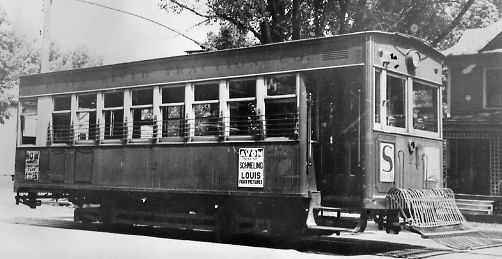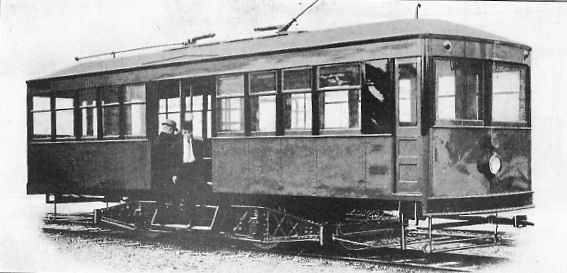Barber Car Company
Mr. LeFebvre had a 28 year old protégé named Edward A. Barber, who had learned electrical and mechanical engineering at Lefebvre’s right hand. Barber invented and installed a “self-operating” power plant that only required human attention once a week. {343} Barber became Superintendent of the car shops at the road’s West Main Street barn, and designed and built 10 cars with a 10 foot wheelbase [and later more with a 12 foot] that had a distinctive square-cut appearance. These single truck trolley cars were a great success despite their harsh and inelegant appearance. {348}
In 1908, Barber formed his own company and built a plant at York, Pennsylvania, former home of several car builders. The first cars built were for the Sunbury [Pennsylvania] & Selinsgrove Street Railway. {347} It must have looked like a good time to get into business, as 1907 had been a very bad year, with the stock market taking a sharp drop in March, followed by an attempt to corner United Copper that sparked a run on the Knickerbocker Trust Company and the Trust Company of America. But J. Pierpont Morgan and others had pledged $25 million to salvage banks beset by runs, and by the end of the year things were looking up. The cars Barber built were all Barber. They had trucks, electrical gear and bodies, all designed and constructed by the Barber company. They were more than sound mechanically, but their awkward appearance apparently doomed wide appeal, even though there was a purpose to it, namely, to force air into the car for ventilation. {347} In 1910 Barber built some cars that were much more conventional in appearance, but with a center door and a “slightly rounded umbrella hood arch roof with head board of even depth across the front.” {347}
But the economic conditions that looked to be improving in 1908 and 1909 “went south” so to speak, and by the end of 1910, the national economy was at a low ebb. A New York Times article was headlined “A Billion Loss in Stock Values.” By 1912, Barber was trying something else unconventional: an electric car that generated its own electricity through a gasoline engine. In May it was demonstrated on the CB&C out of Huntington, Indiana. At the demonstration, it was made known that three of the cars had been purchased by the Chicago, Terre Haute & Eastern. One of the cars had been operating at Sunbury, Pennsylvania, since January 15. {389} In June it was announced that the Barber company was interested in moving from York to Sunbury “as it does not own any of the traction lines in the vicinity of its factory and find it difficult to make the proper tests of the manufactured product.” It wanted to locate along the line of the Sunbury & Selinsgrove system. There was just one condition: that the citizens subscribe $100,000 in preferred stock bearing interest at 7 per cent! {390} We don't know whether the citizens of Sunbury raised the money or not, but it probably wouldn’t matter, for though the national economy had improved by 1914, the railroads weren’t buying cars, and the entire car building industry went into a slump, and the Barber Car Company shut its doors, never to reopen. Cast of Characters —Edward A. Barber (1868-1920+) was born at Watertown, New York. We don’t yet know what kind of education he had. Our only source to date says he “had completed a course in electrical and mechanical engineering under Mr. Lefebvre,” Manager of the Watertown Traction Company. {343} In 1900, Mr. Barber was an electrician. {344} In 1910, he was a manufacturer of street cars. {345} But in 1920 he was a dealer in electrical supplies. {346} We’d like to know more about both Mr. Barber and Mr. LeFebvre. If you can help us, please contact us. For More Information —Cox, Harold E., Barber Car: Electric Traction's Ugly Duckling, Forty Fort, PA: Self-published, 2002.
|

